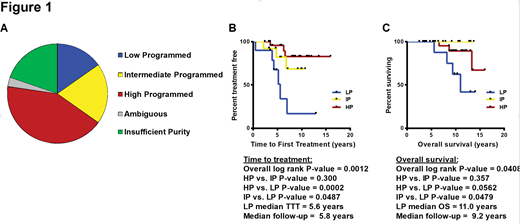Monoclonal B cell lymphocytosis (MBL) has been shown to be the precursor condition that precedes overt diagnosis of chronic lymphocytic leukemia (CLL). Whereas CLL is classified with greater than or equal to 5 × 109/L B lymphocytes in the peripheral blood, MBL is a clonal expansion of B-cells below this threshold. MBL can be further divided into high- or low-count based on whether the B-cell count is above or below 0.5 × 109/L. Approximately 10% of the population over 40 is estimated to have MBL, increasing to >50% over the age of 90. While low-count MBL is unlikely to progress, 1-2% of high-count (HC) MBL individuals progress to CLL requiring therapy per year. It is debatable if all patients with detectable MBL should be classified as an entity requiring monitoring by a hematologist, especially for low-count MBL. In addition, the diagnosis of leukemia is distressing to patients; therefore, it is important to identify HC MBL patients that are more likely to progress to disease requiring treatment and thus should be monitored more closely.
As the majority of MBL cases phenotypically resemble CLL, established prognostic markers including recurrent chromosomal aberrations, beta-2 microglobulin levels, and the mutational status of the Immunoglobulin heavy-chain variable region locus (IGHV) have been shown to predict time to treatment (TTT) and overall survival (OS) in a large retrospective study of MBL1. CLL patients can also be divided into three distinct epigenetic subtypes that reflect progressive DNA methylation changes that occurs during B cell development. These 'epitypes' termed low-programmed (LP), intermediate-programmed (IP), and high-programmed (HP) independently predict clinical outcomes irrespective of disease stage and treatment2. LP-CLL patients follow a generally unfavorable clinical course compared to the more indolent HP-CLL patients, while IP CLL patients display an intermediate outcome. Here we sought to determine if epitype forecasts progression to CLL and eventual clinical outcome for individuals with MBL.
We analyzed 66 individuals diagnosed with HC MBL at the Mayo Clinic with a median follow-up of 6.3 years. Developmental epitype was determined using our novel Methylation-iPLEX technique that interrogates 34 CpGs and assigns epitype using a random forest model2. Seventy-seven percent of the MBL cases were assigned to one of the three epitypes: 42.4% HP, 19.7% IP, and 15.2% LP. The residual 23% remained unclassified due to ambiguous (low confidence) epigenetic patterns or insufficient purity (Figure 1A). The overall proportion of HP and IP epitypes in MBL were significantly greater than proportions observed in CLL cohorts (P<0.01). Epitypes remained stable over time as 20/21 cases for which we obtained a high-confidence epitype classification at multiple time points remained unchanged. Epitype significantly predicted MBL individuals progressing to treatment (P=0.001) with LP individuals progressing in a median of 5.6 years (P=0.049 and P=0.0002 versus IP and HP, respectively); median was not reached in HP or IP (Figure 1B). Epitype also predicted overall survival (OS) in MBL (P=0.04), with LP individuals having a significantly shorter OS (median of 11 years versus not reached in IP and HP; P=0.056 and P=0.048 versus IP and HP, respectively).
In this study we evaluated a cohort of 66 HC MBL cases and determined that classification using developmental DNA methylation epitypes can be employed in HC MBL to aid in risk stratification. HC MBL patients classified as LP are more likely to progress to requiring treatment and have a significantly reduced OS. The epigenetic classification may help clinicians decide how closely and frequently a HC MBL individual needs to be monitored.
Figure 1: (A) Breakdown of the epigenetic subtype assigned to 66 HC MBL samples. (B) Kaplan-Meier analysis of time to treatment and (C) overall survival of MBL patients separated by epitype.
1. Parikh, S. A. et al. Outcomes of a large cohort of individuals with clinically ascertained high-count monoclonal B-cell lymphocytosis. Haematologica103, e237-e240 (2018).
2. Giacopelli, B. et al. Developmental subtypes assessed by DNA methylation-iPLEX forecast the natural history of chronic lymphocytic leukemia. Blood blood.2019000490 (2019). doi:10.1182/blood.2019000490
Byrd:Ohio State University: Patents & Royalties: OSU-2S; Janssen: Consultancy, Other: Travel Expenses, Research Funding, Speakers Bureau; BeiGene: Research Funding; TG Therapeutics: Other: Travel Expenses, Research Funding, Speakers Bureau; Novartis: Other: Travel Expenses, Speakers Bureau; TG Therapeutics: Other: Travel Expenses, Research Funding, Speakers Bureau; Genentech: Research Funding; Gilead: Other: Travel Expenses, Research Funding, Speakers Bureau; Novartis: Other: Travel Expenses, Speakers Bureau; Ohio State University: Patents & Royalties: OSU-2S; Gilead: Other: Travel Expenses, Research Funding, Speakers Bureau; Acerta: Research Funding; Genentech: Research Funding; Pharmacyclics LLC, an AbbVie Company: Other: Travel Expenses, Research Funding, Speakers Bureau; Pharmacyclics LLC, an AbbVie Company: Other: Travel Expenses, Research Funding, Speakers Bureau; Acerta: Research Funding. Shanafelt:Patent: Patents & Royalties: US14/292,075 on green tea extract epigallocatechin gallate in combination with chemotherapy for chronic lymphocytic leukemia; Merck: Research Funding; Polyphenon E International: Research Funding; Pharmacyclics: Research Funding; Genentech: Research Funding; Hospira: Research Funding; Glaxo-SmithKline: Research Funding; Abbvie: Research Funding; Cephalon: Research Funding; Celgene: Research Funding. Parikh:Genentech: Honoraria; Janssen: Research Funding; AstraZeneca: Honoraria, Research Funding; Pharmacyclics: Honoraria, Research Funding; MorphoSys: Research Funding; AbbVie: Honoraria, Research Funding; Acerta Pharma: Research Funding; Ascentage Pharma: Research Funding. Kay:Agios: Other: DSMB; MorphoSys: Other: Data Safety Monitoring Board; Infinity Pharmaceuticals: Other: DSMB; Celgene: Other: Data Safety Monitoring Board.
Author notes
Asterisk with author names denotes non-ASH members.


This feature is available to Subscribers Only
Sign In or Create an Account Close Modal